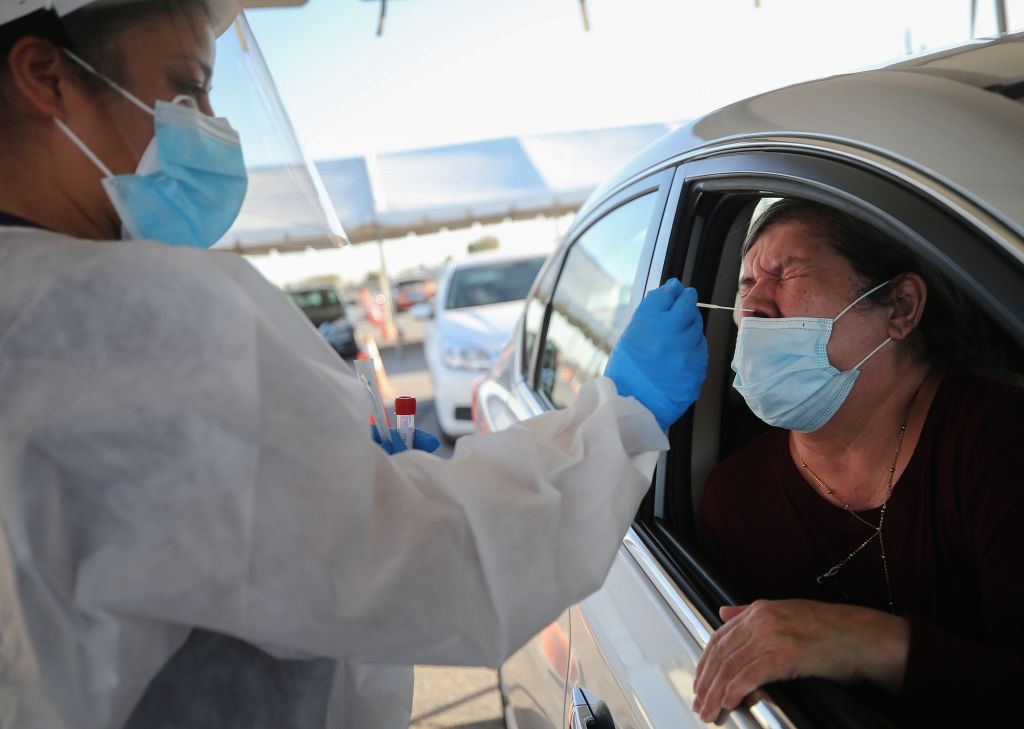
Over the past few days, my social media feeds have been jam-packed with pictures and videos of COVID-19 testing lines that stretch multiple blocks. Some people report waiting hours for their turn, while others say they’re being turned away before ever getting the chance. It’s not just here in the New York metro area, either—similar delays are being reported around the country.
The intense testing demand is at least partially due to the fact that the virus is spiking across the U.S.; it’s natural that more people would seek testing as their risk of exposure increases due to local outbreaks. But this new wave of demand also comes just a few days before Thanksgiving, and multiple friends working at testing sites have told me that many people are seeking tests specifically because they’re planning to gather with family this week.
Public-health officials, epidemiologists, doctors and nurses have been begging people to stay home this Thanksgiving amid fears that the holiday will be a national super-spreader event. But optimism bias—the idea that “it won’t happen to me”—is a hell of a drug, and many people are choosing to congregate despite the risks (air travel this weekend approached its highest pandemic-era point yet).
If you’ve decided to gather with friends or family this Thanksgiving, getting a test first is certainly better than not getting one at all—if you test positive, you clearly know that you should cancel your plans and stay home. All this testing will result in better, more complete data, too. But what some people don’t seem to realize is this: receiving a single negative COVID-19 test result days before a gathering can’t guarantee that you won’t wind up infecting others at that event.
Why? Once you’re exposed to the virus, it can take several days for it to replicate in your body to the point that you would test positive—this is called the “incubation period.” The upshot is this: You could be exposed on a Sunday, test negative the next day, but be contagious by Thursday. Moreover, in the Thanksgiving context, it’s also possible to test negative today, pick up the virus while traveling home, then be infectious by the time everyone’s together on Thursday. And don’t forget that about 40% of people with COVID-19 never experience symptoms, so you could still be a carrier even if you’re feeling fantastic.
Tests are only one part of the pandemic toolbox, best used in combination with a 14-day quarantine period. A single negative test is good news, but not free license to forgo other precautions. And the danger here goes beyond you and your immediate family—when it comes to an infectious disease like this one, we’re all potential links in a chain. If you wind up spreading the virus at the Thanksgiving table, even if nobody in your family gets ill, they could then go on to infect others, who could wind up sick, or worse. That’s why experts want you to stay home—it’s not just about individual health, it’s about public health.
My advice? Stay home, hop on Zoom with the family (the company’s lifting its typical 40-minute limit this year), and do everything you can to break those chains. “A Zoom Thanksgiving is better than an ICU Christmas,” has become this year’s unofficial PSA. I couldn’t agree more. And if you need some help having that difficult conversation with your family, we’ve got you covered.
This story was adapted from The Coronavirus Brief, TIME’s daily COVID-19 newsletter. Click here to sign up.
More Must-Reads from TIME
- L.A. Fires Show Reality of 1.5°C of Warming
- Home Losses From L.A. Fires Hasten ‘An Uninsurable Future’
- The Women Refusing to Participate in Trump’s Economy
- Bad Bunny On Heartbreak and New Album
- How to Dress Warmly for Cold Weather
- We’re Lucky to Have Been Alive in the Age of David Lynch
- The Motivational Trick That Makes You Exercise Harder
- Column: No One Won The War in Gaza
Contact us at [email protected]